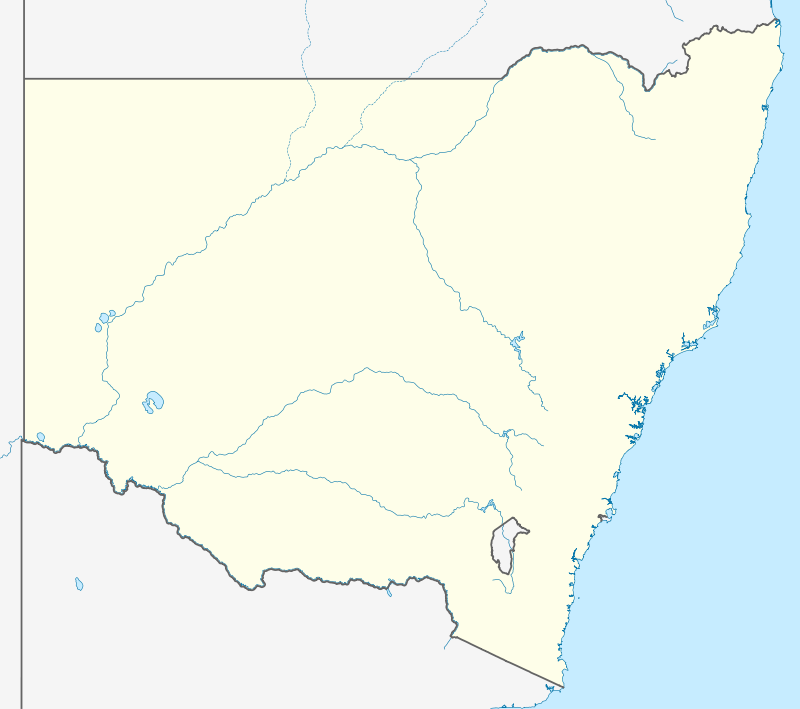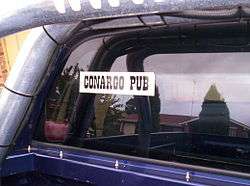Conargo
Conargo /kɒˈnɑːrɡoʊ/ is a town in the Riverina region of New South Wales, Australia. The town is in the Edward River Council local government area. It is on the Billabong Creek, a tributary of the Murrumbidgee River. The nearest towns are Jerilderie and Deniliquin. At the 2006 census, Conargo had a population of 188 people.[1]
| Conargo New South Wales | |
|---|---|
The "famed" Conargo Pub praised by the Ute Muster sub-culture | |
 Conargo | |
| Coordinates | 35°19′S 145°09′E |
| Population | 188 (2006 census)[1] |
| Postcode(s) | 2710 |
| Elevation | 95 m (312 ft) |
| Location |
|
| LGA(s) | Edward River Council |
| County | Townsend |
| State electorate(s) | Murray |
| Federal Division(s) | Farrer |
The Aboriginal name for the locality of Conargo was 'Gooriara', meaning "hopping" or "kangaroo ground".[3]
The actual town itself is quite small, with only a pub, a convenience store that sells fuel and a small number of houses. There are five nearby villages - Blighty, Mayrung, Pretty Pine, Wanganella and Booroorban.[4]
The surrounding rural area consists of large sheep stations, including some Merino studs.
History
In 1859 William McKenzie opened the Conargo Inn there (named after the nearby "Conargo" pastoral run). A township at Conargo was laid out in 1860 by the surveyor McCulloch. During 1865 another hotel was built at the village - the Riverine Hotel (publican James McKeys). At about the same time the Conargo Inn, together with 320 acres (1.3 km2), was sold for £1,857 to T. Robertson. Conargo Post Office opened on 1 September 1864 and closed in 1988.[5] In 1866 Conargo was reported as having a population of thirty persons, with a post-office, a store, and two hotels. In 1867 the Billabong Hotel was added to Conargo's hotels (with David Rogers as its first publican). In 1869 the Baker brothers built a store there. In 1872 Conargo was described as a small village with a store and three hotels.[6]
In February 1878 a correspondent to the Town and Country Journal said: "Conargo... was once - according to tradition - intended to be a town, which attempt finally diminished to a total failure". The writer added that the proprietor of the only store in the village had recently died after "a long and continued illness". Of the three hotels it was claimed the Conargo Hotel was the "better house", doing "a great deal more business than the other two combined".[7]
The Conargo Public School opened in 1879.[8]

The Conargo Pub was destroyed by fire on 11 November 2014.[9]
See also
- Bachelor and Spinster Balls
References
- Australian Bureau of Statistics (25 October 2007). "Conargo (State Suburb)". 2006 Census QuickStats. Retrieved 12 July 2009.
- Travelmate Archived 24 March 2007 at the Wayback Machine
- "Conargo". Geographical Names Register (GNR) of NSW. Geographical Names Board of New South Wales.

- Conargo.nsw.gov.au Archived 5 February 2007 at the Wayback Machine
- Premier Postal History, Post Office List, retrieved 11 June 2009
- 'The Western Riverina: A History of Its Development' by James Jervis (Royal Australian Historical Society Journal and Proceedings Vol. XXXVIII 1952), p. 142; Listings of Publicans Licences, New South Wales Government Gazettes.
- Town and Country Journal, 2 March 1878, p. 422.
- "Notice Board". Trove. Australian Women's Weekly. 28 March 1979. p. 82. Retrieved 6 January 2019.
- http://www.dailyadvertiser.com.au/story/2690356/historic-conargo-pub-goes-up-in-smoke-photos-video/?cs=147